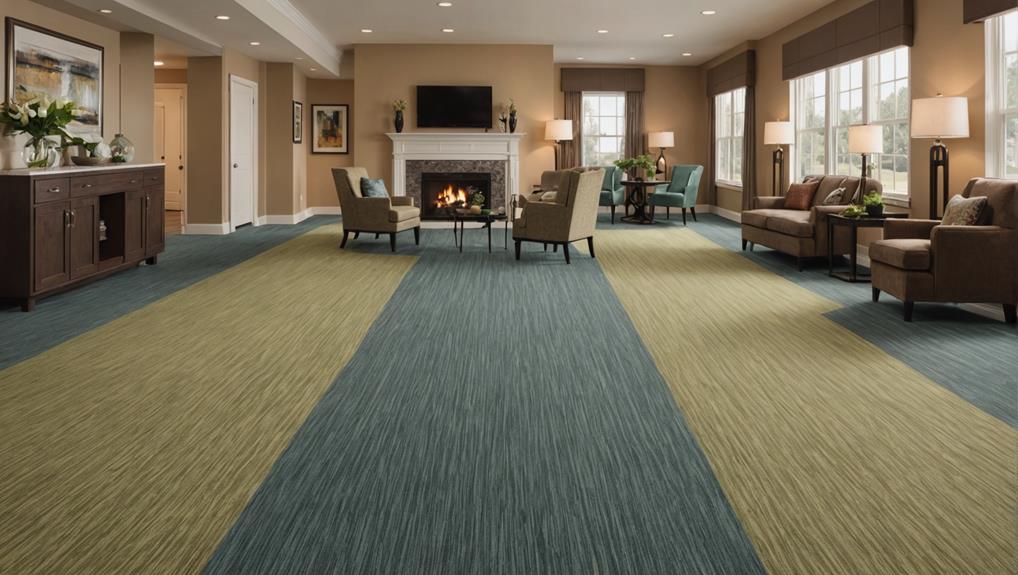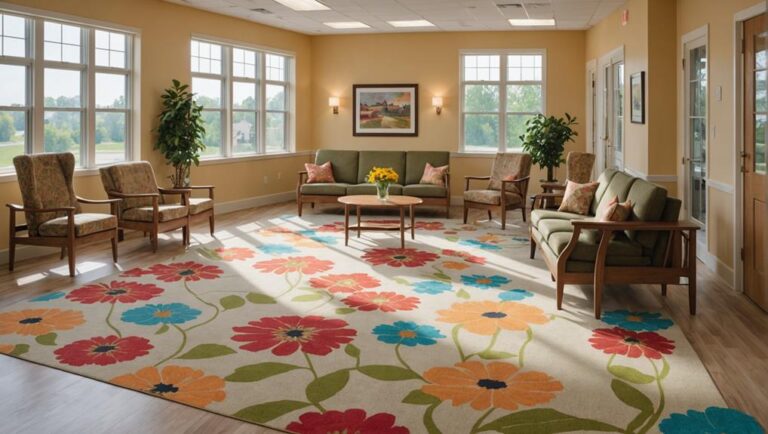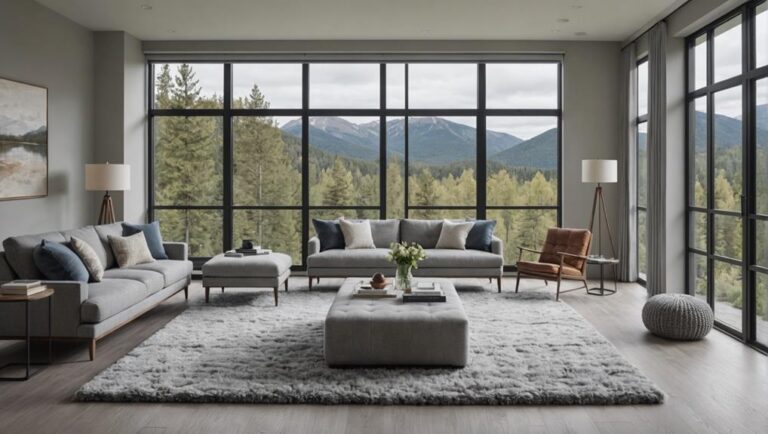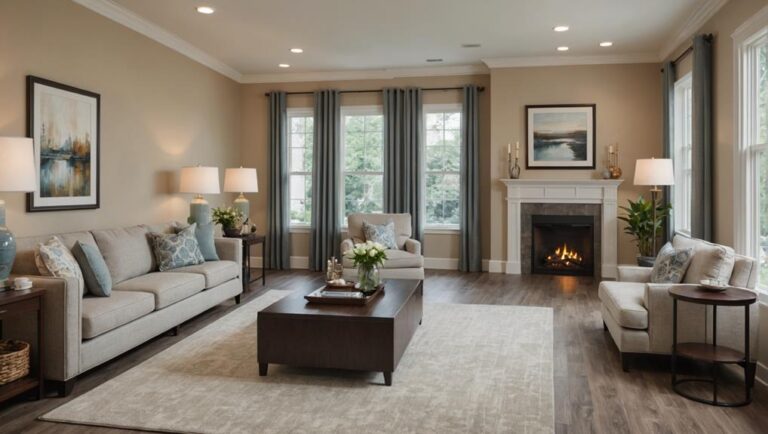When considering flooring for senior living, slip-resistant vinyl shines with its textured surface that boosts traction and reduces slip hazards, especially in busy areas. It also offers easy maintenance and impressive durability, lasting 10 to 20 years while resisting scratches. On the other hand, carpeting provides warmth and sound absorption, creating a cozy environment. However, it can hide tripping hazards and may require more frequent cleaning. Understanding the long-term costs and environmental impact makes vinyl a smart choice for safety and sustainability. Explore how these factors shape your decision for a welcoming space that meets your loved ones' needs.
Safety Considerations
When evaluating flooring options for senior living, prioritizing safety is essential. The right flooring can greatly impact fall prevention, making it an important decision for ensuring a secure environment. Slip-resistant vinyl emerges as a standout choice, designed specifically to enhance traction. Its textured surface provides a reliable grip, reducing the risk of slips and falls, especially in high-traffic areas like hallways and bathrooms.
Imagine walking confidently across a floor that feels stable beneath your feet, where every step is supported by a surface engineered for safety. Unlike traditional carpeting, which can become worn or matted over time, slip-resistant vinyl maintains its traction-enhancing qualities, offering peace of mind in every stride.
On the other hand, carpeting may seem cozy, but its soft fibers can hide foreign objects, increasing the chance of tripping. While it does provide some cushioning, it often lacks the necessary grip for those who may be unsteady on their feet.
In spaces where seniors gather, the choice of flooring should reflect a commitment to their safety and well-being. Visualize a home where every corner is designed with care, where fall prevention is at the forefront of design choices. Choosing flooring that prioritizes traction enhancement not only fosters a safer living environment but also promotes independence, allowing seniors to move about freely with confidence. In this journey towards safety, selecting the right flooring becomes more than just a decision; it's an essential step toward enhancing quality of life.
Maintenance and Durability
Maintaining a clean and durable flooring option is essential in senior living environments, and this is where slip-resistant vinyl shines. Unlike carpeting, which can trap dirt and allergens, slip-resistant vinyl offers a smooth surface that's easy to clean. Regular maintenance is key to ensuring safety and longevity. You'll find that with slip-resistant vinyl, the cleaning frequency is considerably reduced—just a quick sweep or mop is often all it takes to keep it looking fresh.
When you consider wear resistance, vinyl outperforms carpeting in high-traffic areas. Its tough surface can endure the daily activities of seniors, minimizing the risk of scratches or dents. This durability means you won't have to worry about frequent replacements or repairs, making it a cost-effective choice in the long run.
Here's a quick comparison to help visualize the benefits:
| Feature | Slip-Resistant Vinyl | Carpeting |
|---|---|---|
| Cleaning Frequency | Low | High |
| Wear Resistance | High | Moderate |
| Maintenance Effort | Minimal | Substantial |
| Longevity | Long-lasting | Shorter lifespan |
Comfort and Aesthetics
While safety and durability are essential in senior living spaces, comfort and aesthetics play a significant role in creating a welcoming environment. Choosing the right flooring can transform a space, making it not only safer but also more inviting. Both slip-resistant vinyl and carpeting offer unique advantages, so it's important to evaluate how each option meets your needs.
Slip-resistant vinyl provides various texture options that can enhance grip and comfort underfoot, while still being easy to maintain. You can choose from a range of colors, allowing you to create a warm, personalized atmosphere. On the other hand, carpeting can bring a cozy, home-like feel, with soft textures that may be appealing to seniors seeking comfort.
When exploring these flooring choices, assess the following:
- Texture Options: Slip-resistant vinyl often mimics the look of natural materials, while carpeting offers plush, cushioned surfaces.
- Color Choices: A wide palette can influence mood; calming blues or vibrant yellows can invigorate a space.
- Warmth: Carpeting retains heat, making spaces feel cozier in cooler months.
- Sound Dampening: Carpets absorb sound, creating quieter environments, which could be beneficial for seniors.
- Personalization: Both options allow for unique designs that reflect personal tastes and preferences.
Ultimately, blending comfort with safety is essential in senior living environments, ensuring that residents feel at home while remaining secure.
Cost Analysis
Although both slip-resistant vinyl and carpeting can enhance the safety and comfort of senior living spaces, their costs can vary considerably, impacting your decision. When considering installation expenses, you'll find that slip-resistant vinyl is typically more cost-effective upfront. However, it is crucial to think about long-term savings, as this material often requires less maintenance and can withstand wear and tear better than carpeting.
Here's a breakdown of the cost factors to help you visualize the differences:
| Cost Factor | Slip-Resistant Vinyl | Carpeting |
|---|---|---|
| Installation Expenses | $2 – $5 per square foot | $3 – $7 per square foot |
| Maintenance Costs | Low (easy to clean) | Moderate (carpet cleaning) |
| Lifespan | 10 – 20 years | 5 – 15 years |
| Long Term Savings | Higher due to durability | Lower due to replacement costs |
In the long run, investing in slip-resistant vinyl might save you money due to its durability and lower maintenance needs. On the other hand, carpeting might offer a warmer ambiance but can lead to higher replacement costs as it wears out more quickly. So, take your time to weigh these factors carefully, considering not just the initial investment, but also the safety and comfort of your senior living spaces over time.
Environmental Impact
Considering the environmental impact of flooring choices is essential for creating sustainable senior living spaces. When you explore the options of slip-resistant vinyl and carpeting, it's vital to think about how each material affects the planet. Both options can have varying degrees of sustainability, largely influenced by their material sourcing and production methods.
Slip-resistant vinyl often utilizes recycled materials and can be manufactured with less energy, making it a practical choice for environmentally-conscious settings. On the other hand, traditional carpeting can be less sustainable due to its reliance on petroleum-based products and the potential for harmful off-gassing.
Here are some key considerations for making an eco-friendly flooring choice:
- Material Sourcing: Look for products made from renewable or recycled resources.
- Durability: Choose flooring that lasts longer to reduce waste and replacement needs.
- Maintenance: Select options that require less frequent cleaning and harsh chemicals.
- Certifications: Look for eco-labels that guarantee adherence to sustainability practices.
- End-of-life: Consider how flooring can be recycled or disposed of responsibly.
Frequently Asked Questions
How Do Slip-Resistant Vinyl and Carpeting Affect Indoor Air Quality?
When considering how flooring impacts indoor air quality, it's essential to think about VOC emissions and allergen accumulation. Slip-resistant vinyl typically has lower VOC emissions compared to carpeting, which can trap dust, pet dander, and other allergens. This means you can breathe easier with vinyl, while carpeting may require more frequent cleaning to reduce allergens. Choosing the right flooring can create a safer, healthier environment, ensuring you and your loved ones feel comfortable and secure indoors.
Are There Specific Designs or Patterns That Enhance Safety for Seniors?
When choosing flooring, you'll find that specific designs and patterns can enhance safety for seniors. Look for options with visual contrast, as they help define spaces and pathways. Opt for textured surfaces that provide grip, reducing the risk of slips. Patterns that are simple yet striking can guide movement, creating a sense of security. By prioritizing these elements, you're not just enhancing aesthetics; you're also fostering a safer, more supportive environment for everyone.
Can Slip-Resistant Vinyl Be Installed Over Existing Carpeting?
You might think about installing slip-resistant vinyl over existing carpeting, but it comes with installation challenges. Carpeting can create uneven surfaces that may compromise the integrity of the vinyl. Additionally, flooring compatibility is essential; not all carpets allow for a stable base. It's best to assess the current flooring condition before proceeding. Ensuring a flat, secure surface will enhance safety and longevity, making your space both aesthetic and practical for everyday use.
What Are the Fire Safety Ratings for Slip-Resistant Vinyl and Carpeting?
When considering fire safety ratings, it's crucial to compare materials. Slip-resistant vinyl generally has a better fire safety rating due to its synthetic composition, which often meets stricter regulations. Carpeting, while cozy, can be less fire-resistant unless treated with special chemicals. You'll want to prioritize safety in your choice, ensuring the flooring you select not only feels good underfoot but also provides peace of mind in the event of a fire.
How Do Temperature Variations Affect Slip-Resistant Vinyl Compared to Carpeting?
Temperature variations can greatly impact materials. With slip-resistant vinyl, you might notice temperature sensitivity leading to thermal expansion, causing it to expand or contract in response to heat. This can affect its fit and potentially create gaps. In contrast, carpeting remains relatively stable, providing a consistent surface. However, extreme temperatures can still affect its cushioning and durability. Understanding these differences can help you choose the safest flooring option for your needs.




